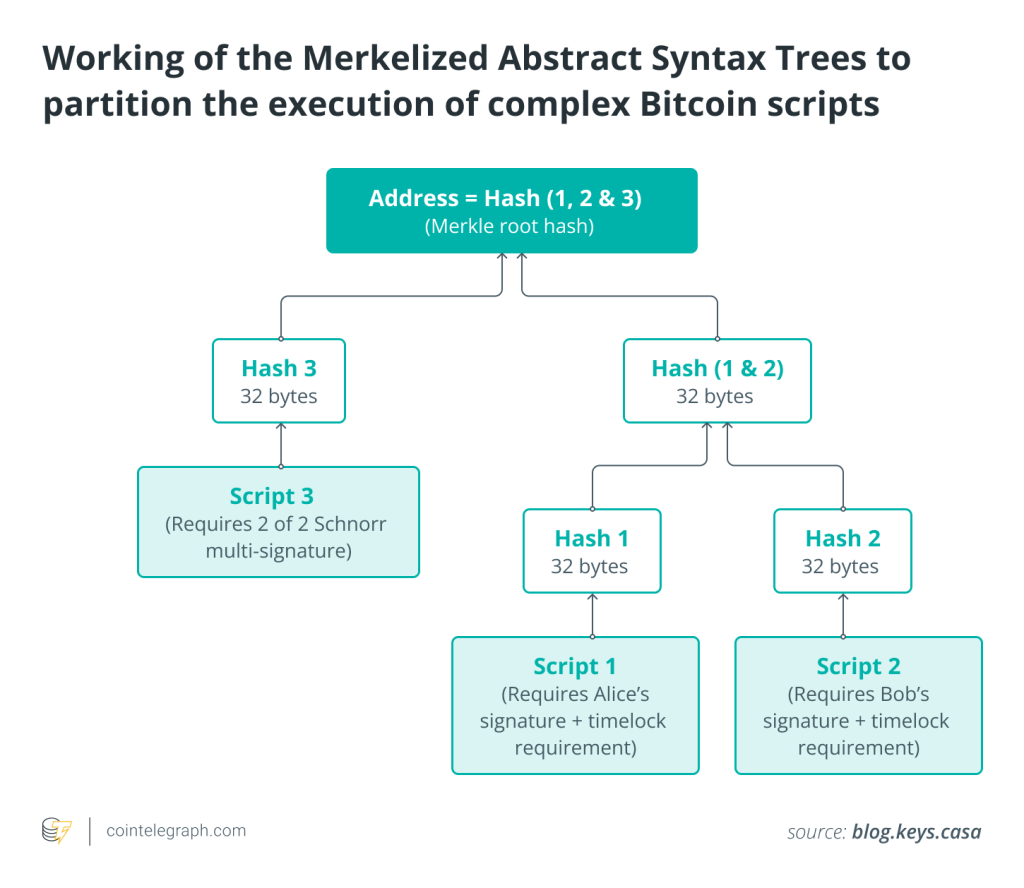A beginner's guide to the Bitcoin Taproot upgrade


Bitcoin Taproot upgrade explained
Bitcoin Taproot update is the most important upgrade the cryptocurrency has experienced since 2017, when Segregated Witness (SegWit) was activated. Like SegWit, the Taproot upgrade aims to improve the privacy and efficiency of the network but on a larger scale and with a potentially more significant impact expected over the years.
Bitcoin Taproot upgrade will also encourage the implementation of smart contracts, which can be used to eliminate intermediaries from transactions and open the door to decentralized finance (DeFi) for the top cryptocurrency.
On June 12, 2021, Bitcoin miners signaled their support for the upgrade with a 90% consensus. However, the Bitcoin Taproot upgrade date was not finalized until November 2021 and was fully activated as a soft fork of the protocol at block 709,632 on Nov. 14, 2021.
The six months between the lock-in and the activation were programmed to allow node operators and miners to fully upgrade to the latest Bitcoin Core version 21.1, which contains the Taproot upgrade.
This article highlights the most significant changes that the Taproot upgrade enforces in the Bitcoin protocol and how Bitcoin will benefit from them over the years.
Who developed Taproot Bitcoin?
Bitcoin Core developers have explored ways to expand SegWit capability since its implementation in 2017. One of the cryptocurrency’s leading developers, Greg Maxwell, first submitted the Taproot proposal in 2018.
Pieter Wuille is the author of the three Bitcoin Improvement Proposals (BIPs) that codified Taproot. In 2020, developers Tim Ruffing, A.J. Townes and Jonas Nick joined the project and worked on implementing the upgrade alongside Maxwell and Wuille.
Being a soft fork of Bitcoin, Taproot is backward compatible with the older versions of the software and won’t need to separate into two different parallel blockchains and cryptocurrencies, as had been the case for Bitcoin Cash.
In 2017, SegWit became notorious for the dramatic effects it had on the cryptocurrency, which led to the split of the network and the creation of Bitcoin Cash. That upgrade expanded the size of Bitcoin blocks without compromising crucial properties like decentralization.
The opposite side was advocating for bigger blocks without implementing SegWit. Since the consensus on the same protocol was no longer in place, the need to hard fork the Bitcoin blockchain emerged, and two different cryptocurrencies were created, Bitcoin (BTC) and Bitcoin Cash (BCH).
The Taproot upgrade is not as controversial as SegWit and is not a hard fork. It had extensive support among miners right away, partly because it brought significant gradual improvements to the code.
While miners have already widely updated their systems to the latest version of Bitcoin software, other players, such as exchanges, merchants and regular node operators, will upgrade gradually, according to their priorities.
Despite massive support across the board, Taproot adoption is expected to grow gradually over time, as happened with the SegWit upgrade. The impact on DeFi through smart contracts will also be noticed over the years, but it’s expected to be significant.
What is the Taproot and how does it benefit Bitcoin?
The ultimate objective of the Taproot is to make Bitcoin faster, more efficient and private.
The update allows multiple signatures and transactions to be batched together, making verifying transactions on Bitcoin's network faster and more straightforward.
Here’s how the Taproot benefits Bitcoin
Bitcoin’s standard process before the Taproot implies that transactions get verified individually by validating a digital signature — which is like a user’s fingerprints — against a public key. The Taproot upgrade lets multiple and complex signatures like multi-signature wallets be aggregated and verified together, rather than individually.
The main change that will enable this significant transition is the implementation of Schnorr signatures over the Elliptic Curve Digital Signature Algorithm (ECDSA). The ECDSA algorithm creates a signature from the private key that controls a Bitcoin wallet and verifies that the rightful owner carries out the transaction.

Schnorr signatures are more secure than ECDSA. Their linearity allows complex transactions to be verified quickly in batches rather than individually as a single transaction. Multiple collaborating parties can produce a single signature valid for the sum of their public keys, enabling a more straightforward and more efficient method.
By aggregating signatures, the network can process more transactions, making the overall operation faster and cheaper, maximizing the block’s space savings. The Taproot upgrade will enormously improve Bitcoin’s scalability, which many consider to be one of the main hurdles that hinder Bitcoin’s full-scale adoption.

The Taproot also enhances privacy since there won’t be more distinction between multi-signature and single-signature transactions. This way, it becomes more difficult to identify each participant’s transaction inputs where the private data is stored.
The Taproot achieves a significant milestone by allowing Bitcoin to host smart contracts without fearing that multiple signatories and their complex transactions could clog the system. The information size becomes a less data-intensive single-signature transaction.
The Taproot upgrade included three interconnected and simultaneous updates
The Taproot upgrade offers the chance to combine three different proposals related and aimed at improving Bitcoin’s scalability. Proposals to change Bitcoin’s protocol or even fix bugs must follow a specific process for submission. In the absence of a central authority, a BIP is used as a standard procedure, starting with simple ideas that developers submit to the community.
When the proposal receives the relevant attention of other developers, it gets published to the Bitcoin Core GitHub repository of BIPs waiting for activation. The Taproot upgrade includes three concurrent BIPs, as explained below.
BIP 340 – Schnorr Signatures
Schnorr replaces ECDSA and provides a digital signature scheme that is faster, more secure and less data-intensive than ECDSA.
BIP 341 – Taproot
Taproot offers a new way to perform Bitcoin transactions by enhancing privacy and flexibility for users. It also activates Merklized Alternative Script Trees (MAST), which condense complex Bitcoin transactions into a single hash, reducing transaction fees, minimizing memory usage and improving Bitcoin’s scalability.

BIP 342 – Tapscript
Tapscript is the scripting language used for Taproot script-path spends. This update leverages Schnorr’s efficiency and enables more flexibility on future upgrades.
Bitcoin Taproot Smart contracts
The Taproot upgrade is a game-changer for Bitcoin’s utility as it makes smart contracts cheaper and smaller, due to the reduced space they occupy on the blockchain. Smart contracts are blockchain-based self-executing agreements between two individuals that can create a secure transaction without the need for an intermediate.
The Taproot’s way of solving scalability empowers Bitcoin’s ability to host smart contracts on the base chain. This way, the top cryptocurrency emerges as a direct competitor of its more popular smart contract contestant, Ethereum.
This update opens a myriad of new opportunities for Bitcoin as smart contracts provide plenty of potential for real-world applications. Decentralized finance (DeFi) is one of the smart contracts' most powerful applications. They can facilitate the possibility of borrowing or lending money securely without the intermediation of a third party like a bank or a financial institution.
Smart contracts can also be used for any kind of transaction and everyday practical activities, from paying rent every month to registering ownership of an item.
What the Bitcoin Taproot upgrade means for investors
The Taproot is a technical upgrade, and most users won’t even notice that it happened. However, investors should be paying attention to this event as the potential effects over the years might be enormous for the top cryptocurrency.
The Taproot is the long-awaited solution to many of Bitcoin’s conventional problems. Resolving scalability has always been a top priority for Bitcoin’s developers, and the Taproot provides the relevant tools needed to make Bitcoin faster and more efficient.
As a result, fees become lower since the data size of complex transactions will decrease, leaving space for more entries to be processed on the blockchain. The Taproot will directly affect the cost-efficiency and functionality of the Lighting Network, which becomes more flexible for developers who want to build on it, cheaper and more private for users.
This lays the technical foundation for accelerating DeFi’s peer-to-peer financial services on the Bitcoin network. The Taproot expands Bitcoin’s utility, offering a great new opportunity for entrepreneurs looking to invest in the cryptocurrency’s potential with a long-term plan. By creating a more stable and efficient structure, the Taproot should offer investors more confidence in the top cryptocurrency fundamentals.
Concerning the price, the impact of the Bitcoin Taproot upgrade remains to be seen over the years. In the days before the Taproot upgrade, Bitcoin’s value experienced a massive rise, culminating in the all-time high of $64,000 on Nov. 12, 2021. A series of events, including El Salvador’s adoption of Bitcoin as legal tender and its viability as a hedge against inflation, led to a price surge for the cryptocurrency.
However, analysts claim that the Taproot also significantly increased Bitcoin’s value as confidence keeps building over the network. However, it is difficult to predict how the upgrade will impact Bitcoin’s price in the future. At the moment, it looks like the soft fork is already priced in, and mainly, the network efficiency will benefit from it with no direct impact on the short-term price movements.
Undoubtedly, Bitcoin’s potentially expanded adoption of smart contracts will take up a significant market share from other smart contract platforms like Ethereum (ETH), Solana (SOL) or Cardano (ADA).
Whether institutional and mainstream participants stick to the existing platforms or switch to Bitcoin will be an exciting challenge to watch over the next few years.






… [Trackback]
[…] Read More Info here to that Topic: x.superex.com/academys/beginner/2441/ […]
… [Trackback]
[…] Read More Info here to that Topic: x.superex.com/academys/beginner/2441/ […]
… [Trackback]
[…] Find More Information here on that Topic: x.superex.com/academys/beginner/2441/ […]
… [Trackback]
[…] Find More on to that Topic: x.superex.com/academys/beginner/2441/ […]
… [Trackback]
[…] Read More Information here on that Topic: x.superex.com/academys/beginner/2441/ […]
… [Trackback]
[…] Information on that Topic: x.superex.com/academys/beginner/2441/ […]
… [Trackback]
[…] Info on that Topic: x.superex.com/academys/beginner/2441/ […]
… [Trackback]
[…] Find More on on that Topic: x.superex.com/academys/beginner/2441/ […]
… [Trackback]
[…] Find More here to that Topic: x.superex.com/academys/beginner/2441/ […]
… [Trackback]
[…] Here you can find 29603 more Information on that Topic: x.superex.com/academys/beginner/2441/ […]
… [Trackback]
[…] Find More here to that Topic: x.superex.com/academys/beginner/2441/ […]
… [Trackback]
[…] Find More here on that Topic: x.superex.com/academys/beginner/2441/ […]
… [Trackback]
[…] Read More Info here on that Topic: x.superex.com/academys/beginner/2441/ […]
… [Trackback]
[…] Read More Info here to that Topic: x.superex.com/academys/beginner/2441/ […]
… [Trackback]
[…] Read More here on that Topic: x.superex.com/academys/beginner/2441/ […]
… [Trackback]
[…] There you can find 92736 additional Info on that Topic: x.superex.com/academys/beginner/2441/ […]
… [Trackback]
[…] Read More here on that Topic: x.superex.com/academys/beginner/2441/ […]
… [Trackback]
[…] Find More to that Topic: x.superex.com/academys/beginner/2441/ […]
… [Trackback]
[…] There you can find 40297 additional Information on that Topic: x.superex.com/academys/beginner/2441/ […]
… [Trackback]
[…] Here you can find 18546 more Info on that Topic: x.superex.com/academys/beginner/2441/ […]
… [Trackback]
[…] Find More on that Topic: x.superex.com/academys/beginner/2441/ […]
… [Trackback]
[…] Find More Info here to that Topic: x.superex.com/academys/beginner/2441/ […]
… [Trackback]
[…] Information on that Topic: x.superex.com/academys/beginner/2441/ […]
… [Trackback]
[…] There you will find 73787 additional Information to that Topic: x.superex.com/academys/beginner/2441/ […]
… [Trackback]
[…] Information on that Topic: x.superex.com/academys/beginner/2441/ […]
… [Trackback]
[…] Read More on that Topic: x.superex.com/academys/beginner/2441/ […]
… [Trackback]
[…] Find More here to that Topic: x.superex.com/academys/beginner/2441/ […]
… [Trackback]
[…] Find More Information here to that Topic: x.superex.com/academys/beginner/2441/ […]